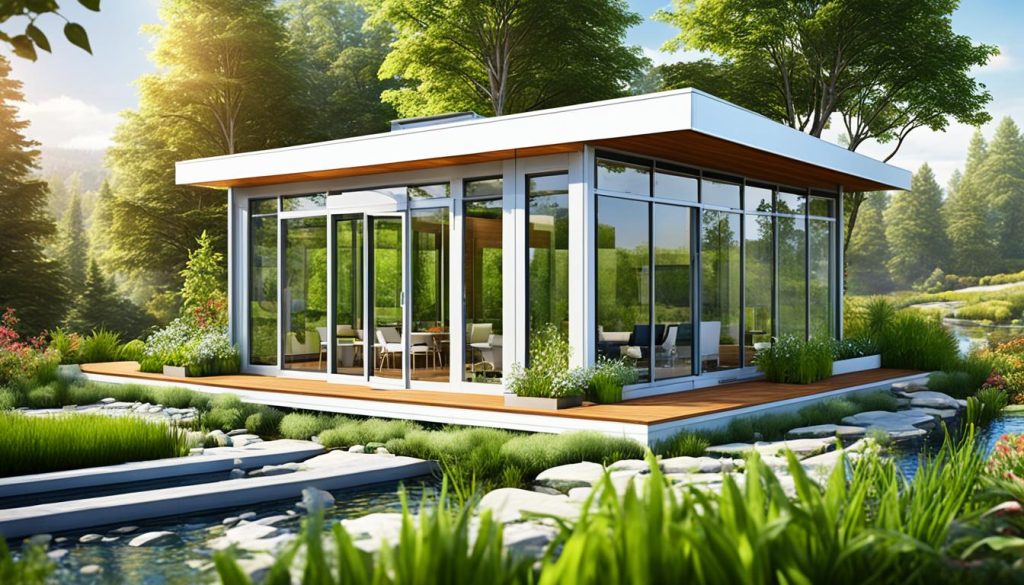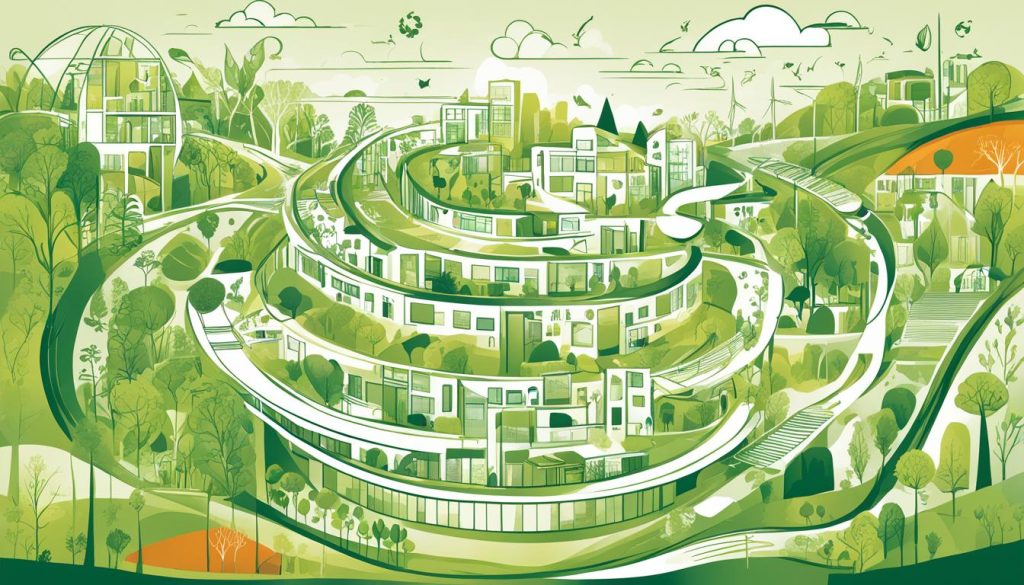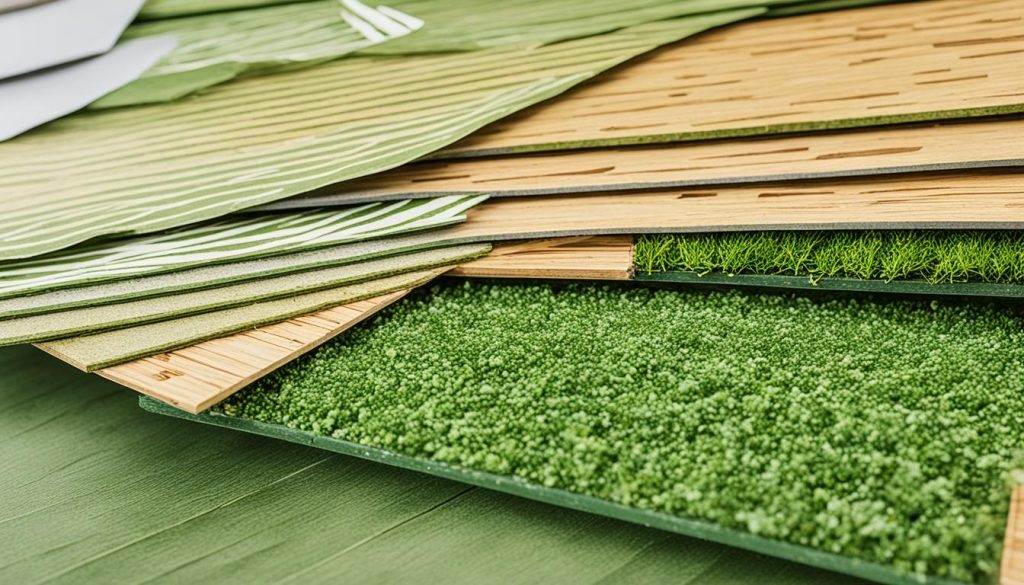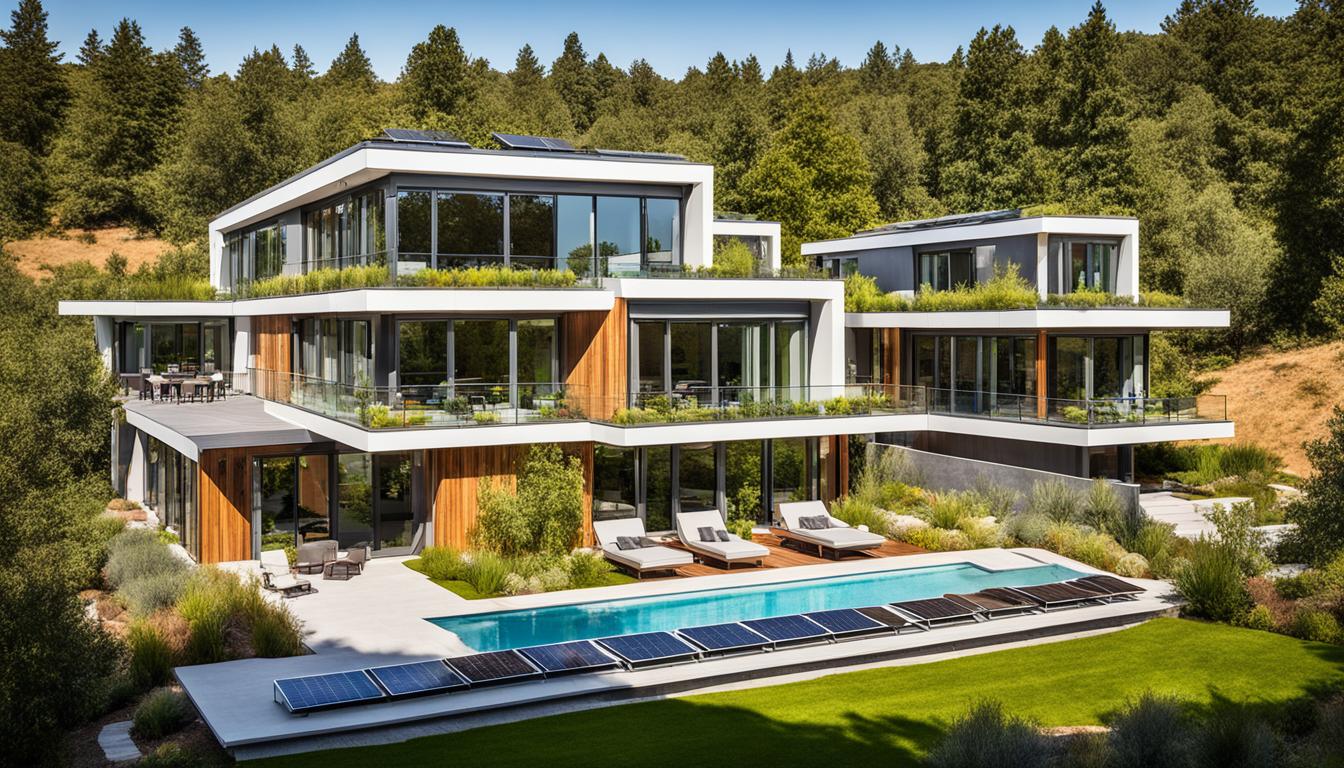I’m excited to talk about prefab green houses. They are a smart and green choice for modern homes. They use new tech in renewable energy and saving water, making living greener.
Prefab green houses mix energy saving, good looks, and custom living spaces well. They use modular building to fit what homeowners want. This keeps them green and stylish.
The tiny home movement and off-grid living are big now. Prefab green houses are a great answer for those wanting to live greener. They use solar panels and geothermal to cut down on energy use. This makes them perfect for eco-friendly living.
Introduction to Prefab Green Houses
Prefab green houses are the future of living sustainably. They use eco-friendly methods to build homes quickly and with less harm to the planet. These homes are made in factories and then put together on-site. This way, there’s less waste and building takes less time.
Eco-Friendly Modular Construction
Modular construction is key to prefab green houses’ green benefits. Parts are made in a factory, using materials that are good for the planet. This method cuts down on waste and makes building more precise and efficient.
Benefits of Prefab Green Homes
- Improved energy efficiency: These homes use smart insulation and energy-saving windows. They also have solar panels to cut down on energy bills.
- Reduced environmental impact: Making and building these homes creates less pollution. They use materials that are good for the earth.
- Faster construction times: Parts are made in a factory, so building takes less time. This means less hassle for everyone.
- Customizable design: You can make your prefab green house your own. Choose features that fit your style and needs.
Prefab green houses are changing how we live sustainably. They offer many benefits and are leading the way to a greener future.
Prefab Green Houses: A Sustainable Choice

Choosing a prefab green house is a smart move for those who want to live sustainably. These homes use renewable materials and energy-saving tech. They also save water. By picking a prefab green house, you help make the planet greener.
Prefab green houses are great at saving energy. They have top-notch insulation and use solar panels and efficient windows. This cuts down on energy use and lowers bills. It’s a smart choice for your wallet and the planet.
These homes focus on using materials that are good for the earth. They use recycled, reclaimed, and local materials. This means less harm to the environment. And they still look great and are well-made.
Water is saved in prefab green houses too. They have fixtures that use less water and systems to collect rainwater. This helps protect our water resources. It’s good for the planet and can save you money on your water bill.
Going for a prefab green house is a choice that’s good for the earth and your life. These homes are a smart, affordable way to live greener. They lead the way to a future that’s better for our planet.
Green Building Certifications

Green building certifications are key for prefab green houses. They make sure these homes are very energy-efficient and good for the planet. LEED and ENERGY STAR are two big names in this area.
LEED (Leadership in Energy and Environmental Design)
LEED is a top green building program from the U.S. Green Building Council. It checks how well a home does in areas like energy use, saving water, clean air inside, and using green materials. Getting a LEED certification means the prefab green house is really good at saving energy and being kind to the earth.
ENERGY STAR
ENERGY STAR is run by the U.S. Environmental Protection Agency and the U.S. Department of Energy. It gives the ENERGY STAR label to products and homes that use less energy and make fewer greenhouse gases. This means a prefab green house with this label uses less energy and saves money on bills.
Getting these certifications shows a big commitment to making homes green. It can also save money with tax credits and rebates. Choosing a LEED or ENERGY STAR prefab home means getting a house that’s good for the planet and saves money.
Sustainable Materials in Prefab Homes

Prefab green houses use eco-friendly materials for building. They focus on sustainable materials to lessen their environmental impact. This helps create a circular economy.
Recycled and Reused Materials
Prefab green homes use a lot of recycled and reused materials. This includes old steel, reclaimed wood, and recycled insulation. Using these materials cuts down on waste and saves natural resources.
Locally Sourced Materials
These homes also use materials from nearby. This helps the local economy and cuts down on carbon emissions. Using local insulation and timber makes prefab green houses more eco-friendly.
| Sustainable Material | Benefits |
|---|---|
| Recycled Steel | Reduces the need for virgin materials, conserves natural resources, and lowers the carbon footprint of the construction process. |
| Reclaimed Wood | Gives new life to existing wood, reducing waste and deforestation, while adding unique character to the home’s design. |
| Locally Produced Insulation | Minimizes the environmental impact of transportation, supports the local economy, and contributes to the energy efficiency of the home. |
Prefab green houses show a big commitment to the environment. They use sustainable materials from start to finish. This makes them a great choice for eco-friendly living.
Energy Efficiency in Prefab Green Houses
Prefab green houses are leading the way in sustainable living. They use many strategies to use less energy and make more renewable energy. This makes them a great choice for eco-friendly homes.
These homes use passive solar design to get energy from the sun. They have windows in the right spots, use top-notch insulation, and face the right direction. This helps them get natural heat and light, cutting down on energy use.
Prefab green houses also have integrated renewable energy systems. They have solar panels on the roof. These panels make clean energy, lowering bills and carbon emissions.
Insulation is key in keeping prefab green houses energy-efficient. They use high-performance insulation materials. This keeps the heat in and the cool air out, saving energy for heating and cooling.
By focusing on energy efficiency, prefab green houses help lower bills and environmental harm. They are a wise and green choice for today’s living.
Water Conservation Features
Prefab green houses are made with saving water in mind. They have features that use less water and help manage water well. These homes use low-flow fixtures like faucets and showerheads. These use much less water but work just as well.
These homes also have systems to collect and use rainwater. This rainwater is used for things like watering plants and cleaning. Using rainwater helps save local water resources and makes living spaces more sustainable.
Low-Flow Fixtures
Low-flow fixtures use less water with each use. They include faucets, showerheads, and toilets. These devices help save a lot of water without losing comfort or function. By using them, prefab green homeowners help save a lot of water.
Rainwater Harvesting Systems
Prefab green houses often have systems to collect and use rainwater. This water is stored for things like watering plants and washing cars. Using rainwater cuts down on the need for city water, helping to save this valuable resource.
Prefab green houses show a big commitment to saving water and being eco-friendly. With low-flow fixtures and rainwater systems, homeowners can use less water. This makes a big difference in their communities and the planet.
Minimizing Waste in Prefab Construction
I’m excited to talk about how prefab green houses are changing the construction world. They focus on reducing waste. Prefab makers use special methods that make building faster and use fewer resources.
Precision Manufacturing Techniques
Prefab green houses use advanced computer-aided design and automated making. This means they can cut and put together parts with great accuracy. It cuts down on leftover materials that usually end up in landfills.
This careful planning and the controlled factory setting lead to less waste during building. It makes prefab a greener option than old-school building ways.
Using these precise methods also improves prefab green houses’ quality and efficiency. It creates a space that’s good for the planet, looks great, works well, and doesn’t harm the environment.

